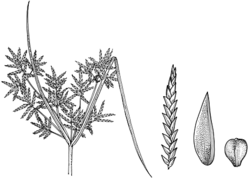Common name: Downs Nutgrass
Cyperus bifax C.B.Clarke APNI* 
Description: Rhizomatous perennial with slender rhizomes producing ovoid tubers c. 5–10 mm diam., woody, with grey-brown fibrous coat persisting for two years.
Culms trigonous, smooth, to 90 cm high, 2–4 mm diam.
Leaves not septate-nodulose, mostly half to three-quarters as long as culm, to 4 mm wide. Inflorescence simple or compound, symmetrical (not thrown to one side), with 2–9 primary branches to 12 cm long; spikes ovoid, to 4 cm long, to 3 cm diam.; involucral bracts leaf-like, 1 or 2 much exceeding the inflorescence. Spikelets flattened, 5–10 per spike, to 10–40 mm long, c. 2.5 mm wide in side view, 10–24-flowered; rachilla winged, persistent. Glumes acute, with sides several-nerved, 3.5–4 mm long, pale brown to red-brown, rarely very dark. Stamens 3. Style 3-fid.
Nut trigonous, broad-obovoid, c. 1.5 times as broad as long, c. 1.2 mm long, c. 0.8 mm diam., greyish.
Flowering: spring–summer.
Distribution and occurrence: Widespread inland, extending towards the coast in the Hunter Valley. Grows on floodplains on heavy clay soils.
NSW subdivisions: NC, NWS, CWS, NWP, SWP, NFWP, ST
Other Australian states: Qld Vic. W.A. N.T.
It withstands heavy grazing, and its system of rhizomes forms a useful soil-binding agent. Occasionally a weed of cultivation, especially in irrigation areas.
Text by K. L. Wilson (1993); edited KL Wilson (Sept 2024)
Taxon concept: Flora of NSW 4 (1993)
APNI* Provides a link to the Australian Plant Name Index (hosted by the Australian National Botanic Gardens) for comprehensive bibliographic data
***The AVH map option provides a detailed interactive Australia wide distribution map drawn from collections held by all major Australian herbaria participating in the Australian Virtual Herbarium project.
|


